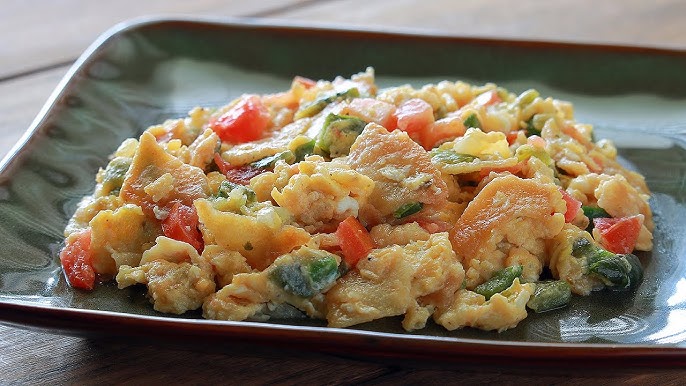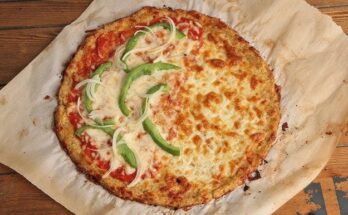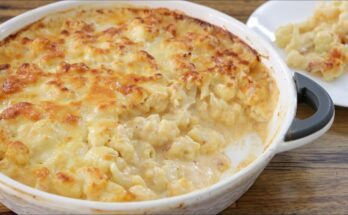Migas Recipe: Are you craving a breakfast dish that’s comforting, flavorful, and super easy to whip up? Meet Migas – the Tex-Mex or Spanish-inspired egg scramble that turns day-old tortillas or bread into magic.
Whether you’re looking for a quick breakfast, a hangover cure, or just a new dish to try on the weekend, this guide will take you through how to make migas step-by-step, packed with tips, tricks, and mouthwatering flavor.
What are Migas?
Migas, meaning “crumbs” in Spanish, are a rustic, comforting dish typically made with leftover bread or tortillas, eggs, and other pantry staples. In the Tex-Mex version, it’s all about scrambled eggs tossed with crispy tortilla strips and flavorful add-ins like onions, jalapeños, tomatoes, and cheese. In Spanish cuisine, migas are bread-based and often served with chorizo or even grapes in some regions.
What makes migas special is their resourceful nature – it’s all about using up what’s in the kitchen and creating something truly delicious. The end result? A satisfying, savory, and customizable dish that wins hearts at the breakfast table every time.
History and Cultural Significance
Migas have a humble origin. In Spain, shepherds would make them using old bread, garlic, and bits of meat. It was the kind of meal that brought warmth and nourishment after a long day’s work. Fast forward to Texas and Mexico, and tortillas took the place of bread, evolving into the migas many people know and love today.
In both cultures, migas are about comfort and community. Whether shared with family on a lazy Sunday morning or served up in a local diner, this dish carries a legacy of simplicity and flavor.
Ingredients You’ll Need
Traditional Tex-Mex Ingredients
Here’s what you’ll typically need to make a hearty batch of Tex-Mex migas:
- 6 large eggs
- 4 corn tortillas (cut into strips)
- 1/2 cup chopped onion
- 1/2 cup chopped tomato
- 1 jalapeño (optional, chopped)
- 1/2 cup shredded cheddar or Monterey Jack cheese
- 2 tablespoons oil (vegetable or canola)
- Salt and pepper to taste
The beauty of migas is how flexible the recipe is. Got bell peppers? Toss them in. Want it spicy? Add hot sauce or chili flakes. It’s your skillet, your rules.
Spanish Migas Variation Ingredients
If you’re aiming for the Spanish version, the ingredient list changes a bit:
- Day-old rustic bread (cut into small chunks)
- Olive oil
- Garlic cloves (sliced)
- Chorizo or bacon
- Paprika
- Salt and optional grapes or fried eggs on the side
This version leans into savory, smoky, and sometimes sweet flavors. It’s heartier, making it great for lunch or dinner.
Tools and Equipment
Must-Have Kitchen Tools
To make migas, you don’t need fancy equipment. Here are the basics:
- Non-stick skillet or cast-iron pan – Essential for even cooking and easy cleanup.
- Spatula – For scrambling and mixing.
- Knife and cutting board – For all your chopping needs.
- Mixing bowl – To beat your eggs ahead of time.
That’s it! Migas are low-effort, high-reward cooking at its best.
Optional Tools to Make Cooking Easier
If you’re feeling fancy or want to speed things up:
- Mandoline slicer – For super quick veggie prep.
- Cheese grater – If you prefer freshly shredded cheese.
- Tortilla cutter – Makes cutting strips fast and even.
But don’t worry—your hands and a good pan are more than enough to get the job done.
Prepping the Ingredients
Chopping Veggies
Good prep is half the battle. Start by finely dicing your onions, tomatoes, and jalapeños (if using). Smaller pieces cook faster and distribute flavor more evenly throughout your migas.
Want to get ahead? Chop everything the night before and store it in airtight containers in the fridge. That way, you can jump straight into cooking when you wake up.
Prepping Tortillas or Bread
For Tex-Mex migas, you’ll need to cut the corn tortillas into thin strips. Don’t worry if they’re a little stale—actually, that’s better! They’ll fry up crispier.
If you’re going the Spanish route, cube your bread into small, bite-sized chunks and let it dry out a bit. The drier the bread, the better it soaks up all those garlicky, meaty flavors without turning to mush.
Beating the Eggs
Crack your eggs into a bowl and whisk them until the yolks and whites are fully combined. Add a pinch of salt and pepper. You can even splash in a bit of milk or cream for extra fluffiness.
Now that you’ve got everything ready to go, it’s time to cook up some magic.
Cooking Migas – Step by Step
Step 1: Fry the Tortillas or Bread
Heat 1-2 tablespoons of oil in a skillet over medium heat. Add your tortilla strips and fry until they’re golden brown and crispy, about 3–4 minutes. Stir occasionally to prevent burning.
If making Spanish migas, heat olive oil and toss in the bread cubes. Cook slowly, letting the bread soak up the oil and get crispy edges.
Remove the tortillas or bread and set them aside on a paper towel to drain excess oil.
Step 2: Sauté the Vegetables
Once your tortilla strips or bread are nice and crispy, it’s time to bring in the flavor. In the same skillet, reduce the heat slightly and toss in your chopped onions, jalapeños, and tomatoes. If you like a little kick, leave some of the jalapeño seeds in.
Cook the veggies until the onions are soft and translucent and the tomatoes have released their juices—about 5–7 minutes. Stir occasionally to avoid burning. The goal is to build a savory, aromatic base that will infuse every bite of your migas with rich, bold flavor.
For Spanish migas, this is when you’d add garlic and chorizo. The garlic sizzles and gets golden, while the chorizo releases its smoky, paprika-rich oils that soak into the bread later.
Don’t rush this part. The longer the vegetables sauté (without burning), the deeper the flavor payoff.
Step 3: Add and Scramble the Eggs
Now it’s time to turn this sauté into breakfast gold. Pour the beaten eggs directly into the skillet over the sautéed veggies. Let them sit for about 30 seconds before you start stirring—this helps set the bottom just a little and creates those creamy, fluffy curds.
Using a spatula, gently push the eggs from the edge toward the center, letting the uncooked eggs flow to the hot pan surface. Keep it low and slow—high heat scrambles eggs too fast, leaving them rubbery.
After about 2 minutes, when the eggs are mostly cooked but still a little soft, go ahead and…
Step 4: Combine Everything Together
Bring those crispy tortilla strips or bread chunks back into the skillet. Stir gently to coat them in the eggs and veggies. At this stage, add shredded cheese if you’re using it. The residual heat will melt it right into the mixture, binding everything together with creamy goodness.
The key is balance—some tortilla pieces should stay a bit crispy, while others soak up the eggs. You’ll get a perfect contrast of textures in every bite. Cook just another 1–2 minutes, until the eggs are set to your liking.
Now your migas are ready to serve! But if you’re feeling a little extra…
Flavor Enhancements and Add-ons
Migas are incredibly customizable. Once you’ve got the base recipe down, you can dress them up or down depending on what’s in your fridge or what flavors you’re craving.
Cheese, Jalapeños, and More
- Cheese: Cheddar, Monterey Jack, Cotija, or Pepper Jack.
- Avocado: A few slices on top add creaminess and a fresh vibe.
- Sour Cream or Mexican Crema: Adds a tangy, cooling contrast.
- Hot Sauce or Salsa: For that bold, spicy kick.
- Green onions or fresh cilantro: For freshness and color.
You can also level up the spice game by adding chili flakes, chipotle powder, or even a spoon of adobo sauce.
Meat or Vegan Options
Meat lovers can toss in:
- Cooked crumbled bacon
- Chorizo
- Diced ham
- Leftover pulled pork
Vegan eaters can:
- Use tofu scramble instead of eggs
- Add sautéed mushrooms for a meaty texture
- Use vegan cheese and plant-based meat substitutes
Migas are the ultimate fridge-cleanout meal. Whatever you’ve got lying around, there’s probably a way to work it in.
Spanish Migas – A Delicious Twist
Now, let’s flip the flavor map and go across the ocean to Spain. If Tex-Mex migas are about eggs and tortillas, Spanish migas are all about crispy bread and smoky, garlicky goodness.
Bread-Based Variation
Spanish migas usually start with day-old rustic bread torn or cut into small chunks. These are soaked briefly in water, just enough to soften them slightly, then dried again. They’re then fried in olive oil with sliced garlic until they turn golden brown and slightly crunchy.
Add-ins typically include:
- Chorizo or other cured meats
- Paprika for color and warmth
- Fried eggs or grapes as a topping (yes, really—sweet and savory at its best)
The dish varies widely depending on the region. In some areas, it’s served for breakfast, while in others, it’s a midday comfort meal. Either way, it’s a delicious alternative if you’re looking to explore more global flavors.
Tips for Perfect Migas
Want to make migas that impress every time? Keep these pro tips in your back pocket:
Avoiding Soggy Eggs
One of the biggest migas fails? Overcooked or soggy eggs. To avoid this:
- Cook your eggs on low heat and pull them off the stove just before they’re fully set—they’ll keep cooking with the residual heat.
- Don’t drown the pan in too many veggies or toppings—too much moisture can ruin the texture.
- Use a non-stick skillet or well-seasoned cast iron for even heat and easy cleanup.
Getting Crispy Tortillas
No one wants limp tortilla strips. For maximum crunch:
- Use day-old or slightly stale tortillas.
- Fry them in a single layer and avoid overcrowding the pan.
- Let them drain on a paper towel to remove excess oil before mixing them into the eggs.
Bonus tip: If you’re short on time, you can even toast the tortilla strips in the oven or air fryer. Just drizzle with oil and cook until golden brown.
Serving Suggestions
Migas are versatile, so you can serve them in a bunch of different ways depending on your mood.
Best Side Dishes
- Refried beans or black beans
- Fresh fruit for balance
- Tortillas for a build-your-own breakfast taco
- Hash browns or roasted potatoes
Want to turn it into a breakfast taco? Just scoop some migas into a warm tortilla, add cheese and avocado, and boom—breakfast is served.
Breakfast, Brunch, or Dinner?
Honestly, migas work for any meal of the day. They’re light enough for breakfast, satisfying enough for lunch, and comforting enough for dinner. Want to stretch them further? Add a side salad or some grilled veggies for a full plate.
How to Store and Reheat Migas
Don’t worry if you’ve made a big batch—migas store surprisingly well, and with the right reheating method, they’re just as tasty the next day.
Best Storage Practices
Once your migas have cooled completely, transfer them to an airtight container. They’ll keep in the refrigerator for up to 3 days. If you’ve added any avocado or fresh toppings, remove those before storing to avoid mushiness.
If you want to freeze them (yes, it’s possible), portion them into individual freezer-safe containers. Just know that the tortillas might lose some of their crunch in the thawing process. Add a sprinkle of fresh cheese or herbs when reheating to revive the flavor.
Reheating Without Losing Texture
To maintain that lovely combo of soft eggs and crispy tortillas:
- Stovetop: The best method. Heat a skillet over medium heat with a touch of oil. Sauté the migas until warmed through and re-crisped.
- Microwave: Quick and convenient, but may make the tortillas soft. Microwave in 30-second bursts, stirring in between.
- Oven or air fryer: Great for larger portions or to get some crunch back. Heat at 350°F for 10–15 minutes.
Fresh toppings like salsa, sour cream, or avocado are best added after reheating.
Common Mistakes to Avoid
Making migas is easy, but there are a few pitfalls that can take them from fabulous to flop.
Overcooking Eggs
Scrambled eggs cook fast—too fast if you’re not careful. High heat or over-stirring can turn them rubbery and dry. Always cook your eggs on low heat, and pull them off the stove when they’re just about done. They’ll finish cooking in the pan’s residual heat.
Skipping the Crunch Factor
The contrast of crispy tortillas or bread with soft, fluffy eggs is what makes migas shine. Don’t skip the step of frying or toasting your tortillas. If they go straight from the bag into the pan, you’ll end up with soggy, limp pieces that drag the whole dish down.
Other common mistakes:
- Not seasoning the eggs – Always add salt and pepper before cooking.
- Using too much moisture – Tomatoes are great, but too many can make things soggy. Drain off extra juice if needed.
- Overcrowding the skillet – This causes uneven cooking. Give everything space to breathe.
Migas vs. Chilaquiles
They may look similar at first glance, but migas and chilaquiles are two totally different breakfast beasts. Let’s break it down.
What’s the Difference?
| Feature | Migas | Chilaquiles |
|---|---|---|
| Tortilla Use | Strips, fried and scrambled | Fried and simmered in salsa |
| Egg Integration | Eggs are scrambled with mix | Often served with a fried egg on top |
| Texture | Crunchy + soft | Softer, saucy texture |
| Sauces | Optional salsa/hot sauce | Main ingredient is salsa |
Migas are all about texture—crispy tortillas mixed into scrambled eggs. Chilaquiles are more like tortilla chip nachos soaked in green or red salsa, often topped with crema, cheese, and an egg or meat.
Which One Should You Try?
Honestly? Both. If you’re after something hearty and eggy with bold texture, go for migas. If you’re craving a saucy, spicy dish with deep Mexican roots, chilaquiles are your move.
You can even get creative and combine the two—start with migas and pour salsa verde over the top for a hybrid dish that hits all the right notes.
Nutritional Information
Wondering what kind of calorie count you’re looking at with a plate of migas? It can vary depending on what you add, but here’s a general breakdown per serving (1 cup of traditional migas):
| Nutrient | Amount (Approx.) |
|---|---|
| Calories | 250–350 |
| Protein | 10–15g |
| Carbs | 15–20g |
| Fat | 15–25g |
| Fiber | 2–4g |
| Sugar | 2–3g |
Healthier Tweaks
Want to lighten things up?
- Use egg whites or a combo of whole eggs and whites.
- Skip or reduce cheese.
- Use whole wheat tortillas or air-fry them instead of pan-frying.
- Add more vegetables for bulk and fiber.
And remember, migas don’t have to be greasy. With fresh, simple ingredients and moderate oil use, they can absolutely be part of a healthy, balanced meal.
FAQs about Migas Recipe
What are migas?
Migas are a traditional Spanish and Mexican dish made from leftover bread or tortillas, eggs, and a variety of ingredients like onions, peppers, and tomatoes. The dish is known for its hearty and comforting nature, making it a popular breakfast or brunch option.
What ingredients do I need for a basic migas recipe?
To make basic migas, you’ll need eggs, corn tortillas (or day-old bread in some versions), onions, green or red peppers, and tomatoes. Optional ingredients include cheese, chorizo, or jalapeños for added flavor.
How do I make migas?
Start by cutting the tortillas into strips and frying them until crispy. Sauté onions and peppers, then add beaten eggs and cook until they begin to set. Stir in the crispy tortillas, tomatoes, and any additional ingredients like cheese or chorizo. Cook until the eggs are fully set.
Are migas gluten-free?
Migas can be gluten-free if made with corn tortillas, which are naturally gluten-free. However, if you’re using bread or flour tortillas, the dish will contain gluten.
Can I add meat to my migas?
Yes, chorizo is a common addition to migas. You can also add other meats like bacon or ham to enhance the flavor and make the dish more filling.
What can I serve with migas?
Migas are often served with refried beans, avocado slices, and salsa. A side of sour cream or a sprinkle of cilantro can also complement the dish well.
Can migas be made in advance?
Migas are best enjoyed fresh, as the tortillas can become soggy if left to sit. However, you can prepare ingredients like the chopped vegetables and meat in advance to speed up the cooking process.
Are there any variations to the traditional migas recipe?
Yes, variations include using different types of cheeses, adding various vegetables like spinach or mushrooms, and even using different spices to create a unique flavor profile.
Final Thoughts
There you have it—migas made easy. Whether you’re whipping up a classic Tex-Mex skillet on a lazy Sunday or experimenting with the rich flavors of Spanish migas, this dish never disappoints. It’s comforting, customizable, and built for flavor. Plus, it’s a fantastic way to repurpose leftovers into something crave-worthy.
So next time you’ve got some tortillas or bread hanging out in the pantry, don’t toss them—turn them into something magical. Grab your skillet, crack those eggs, and get ready for a flavor-packed breakfast you’ll come back to again and again.



